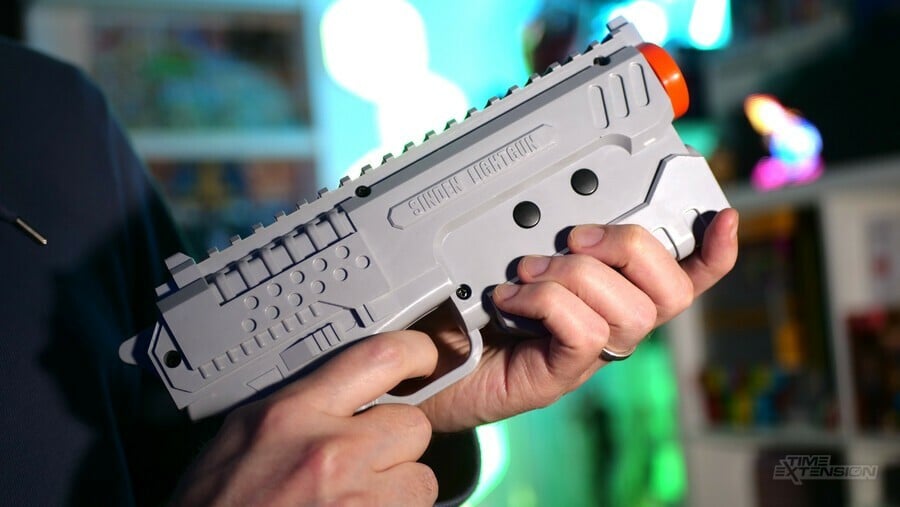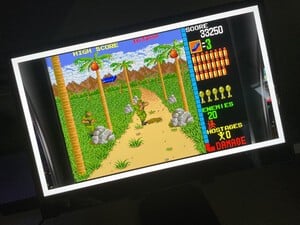
Light gun games aren't a new invention – in fact, some of the earliest games consoles came with their own guns – but in recent years, this unique aspect of video gaming has taken something of a backseat, and that's arguably down to the way 'traditional' light guns work.
Guns like the NES Zapper, Konami Justifier and PlayStation Gun-Con all rely on old-school CRT technology to function – because of this, they won't work on a modern-day LCD, LED or OLED television. That means an entire generation of light gun games is effectively trapped in the past; rendered obsolescent not just because of their host platform, but because the display tech they rely on to function has all but vanished from our homes.
Thankfully, as is so often the case, someone clever has come up with a solution – and that someone is Andy Sinden. The Sinden Light Gun (£89.99) is a modern-day alternative to the traditional light gun that allows you to play classics like Duck Hunt, Time Crisis, Virtua Cop and House of the Dead on your modern flatscreen TV or monitor – and it does so without having to resort to annoying additional hardware, such as Wii Remote-style sensor bars and the like.
According to Sinden himself, the gun uses "smart image recognition with some clever maths and clever software." Contained within the gun you'll find a "high quality and high-speed camera" which looks at the screen and calculates where the player is pointing with the aid of a thin white border added to the edges of the image. This clever system avoids the need for an entanglement of Wii-style sensor bars or cameras around the screen, a dubious 'solution' used by previous modern-day light guns. Sinden adds that the software within the gun captures a frame every 16ms and can calculate movement as quickly as 1ms – giving it parity with the old-school CRT lightguns of yesteryear.

And it doesn't stop there; the Sinden Light Gun can be purchased with an optional recoil upgrade (£139.99) which adds a large solenoid, capacitor and "complex innovative solenoid circuit" to the gun to replicate that authentic, arm-jolting 'recoil' effect often seen in many full-scale arcade light gun games. Incredibly, the gun manages to remain accurate and offer this recoil system without the need for any additional power supply or battery – it's all powered by a standard USB-A connection (the cable is nice and long, too, we should add).
The Sinden Light Gun is available in grey, blue or red plastic and looks a lot like the PlayStation Gun-Con in purely aesthetic terms. It has four buttons – two on either side of the barrel – as well as a D-pad for navigating in-game menus. There's a pump-action bar on the base of the gun as well, and the trigger feels solid and robust. We're reviewing the version with the optional recoil system, and this adds a fair bit of weight to the gun.
So, the Sinden has the tech well and truly nailed down – but what's it actually like to use? Well, the answer to that is a positive one – this is a remarkable piece of kit that really does manage to offer the coin-op experience in your home via your modern-day flatscreen display. Getting it to work might be the most challenging part of the whole thing, but once you've got the proper configuration, it's very much a 'plug-and-play' deal.

The Sinden Light Gun currently supports Windows and Linux. There's already baked-in support for modern-day light gun games on some digital platforms, such as the recent House of the Dead Remake on Steam; these will work right out of the box. However, if you're a fan of old-school arcade shooters, then you'll almost certainly want to try using the gun in conjunction with emulators, and that's where a bit more effort is required.
For the purposes of our review, we used Batocera on a Steam Deck – which required downloading a Batocera image, flashing it to a MicroSD card and booting it as an OS alternative from our Steam Deck. The great thing about Batocera is that it has Sinden support built-in, and once we'd populated the SD card with all of our favourite light gun games, getting it up and running was a breeze.
Via emulators such as MAME, you have access to some of the most famous examples of the genre from the past few decades – games such as Operation Wolf, Lethal Enforcers, Terminator 2, Alien 3: The Gun, Jurassic Park and Point Blank, to name just a handful. There are also system-specific emulators covering the NES, SNES, Mega Drive, PlayStation, Saturn, Dreamcast and Wii, which open up the library even further. Using the Sinden actually comes with some considerable benefits; for example, the reload system in Virtua Cop – which ordinarily requires you to shoot outside of the screen, thus breaking your aim – is mapped to either one of the buttons on the side of the gun or the pump-action reload, which means you can keep your crosshair on your enemy, even during a reload.
For titles like Time Crisis, which, in their original arcade form, made use of a pedal for the hide and reload mechanic, you can either use the button on the side or the aforementioned pump-action bar on the bottom of the gun barrel (Sinden also sells a foot panel which allows you to fully recreate the Time Crisis experience). Oh, and there's support for multiple Sindens, too, if you want to have that all-important two-player experience in your favourite games.
The recoil system we mentioned earlier can also be configured easily in Batocera, which allows you to select from several different strength settings – which is a blessing, as the default option is quite loud. You can choose a machine-gun style setting or a quieter option – which is our preferred choice, as the default is so strong it often drowns out the game audio (you can also disable the recoil entirely if you so wish).
It wasn't long ago that we'd all but given up on the idea of enjoying lightgun games again in this age of flatscreen displays, but the Sinden light gun has answered our prayers. It's incredibly accurate and hassle-free to get up and running – although there are some caveats to consider.

Because the gun is effectively a camera that needs to 'see' the screen border to function, reflections on the screen can throw it off; we found that we got the best performance in a darkened room, where the Sinden has the most precise view of the display. You'll also want to make sure you're the correct distance from the screen to get the most accurate results – Sinden recommends 1.5 meters, but we found that, when using smaller screens, you can get closer than that.
The only genuine drawback with the Sinden Light Gun at present is the limited hardware support. Windows and Linux will be enough for most people (the latter means it works like a dream on Raspberry Pi-based devices), and the lightgun in development for the all-in-one emulation platform Polymega is based on the Sinden.
However, there's scope to improve on this, as Sinden himself is aware; he says he's working on making the gun compatible with original console hardware and has already achieved success with the PlayStation and PlayStation 2 using a special hardware mod. The Sinden isn't currently compatible with the MiSTer, which seems like the next logical step; it will open up the way for totally accurate emulation paired with a brilliant solution for light guns on modern televisions.

But this really does feel like we're needlessly picking fault here. The Sinden light gun works like a charm, is surprisingly accurate and – via optional upgrades, like recoil system and foot pedals – is capable of getting astonishingly close to the original arcade experience.
For £90 / $112 / 101 EUR, it's not exactly in 'impulse purchase' territory, but that's quite a reasonable price when you consider the tech inside, the hard work undertaken by its creator (which, lest we forget, is ongoing) and the fact that it offers one of the best 'at home' light gun experiences money can buy.
Thanks to Andy Sinden for supplying the unit used in this review.
Please note that some external links on this page are affiliate links, which means if you click them and make a purchase we may receive a small percentage of the sale. Please read our FTC Disclosure for more information.
